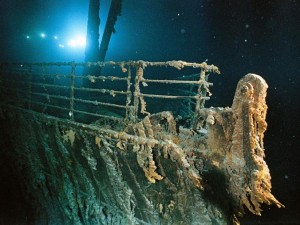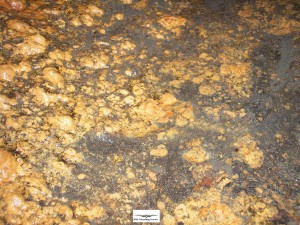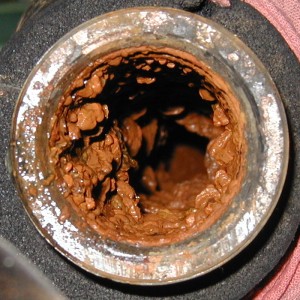For most of the past 100 years it was believed that water pumped from underground aquifers was sterile and free from bacterial contamination. It was thought that by percolating down through the earth, sand, and stone, water was filtered of all microbial life That in turn, meant that aquifers were in effect simply sterile, natural, underground storage tanks.  Recent research however, has shown that belief to be to be false. Bacteria have now been discovered everywhere scientists look… from 4,000 degree, sulphur spewing, thermal vents at the bottom of the sea to 750,000 year old glacial ice, to the insides of solid rock millions of years old. It ends up that bacteria are rugged and resilient and they are everywhere.
Recent research however, has shown that belief to be to be false. Bacteria have now been discovered everywhere scientists look… from 4,000 degree, sulphur spewing, thermal vents at the bottom of the sea to 750,000 year old glacial ice, to the insides of solid rock millions of years old. It ends up that bacteria are rugged and resilient and they are everywhere.
It was also thought that corrosion, fouling, and plugging of water wells, storage tanks, pumps and water delivery systems was solely the result of geo-chemical processes. We now know that this corrosion is often also the result of
microbial action. The reason that all these damaging and costly bacterial infections remained unknown for so long can be summed up in one very important word, Biofilm.
Biofilms are microbial communities made up of hundreds to thousands of different species of water borne bacteria that have left their free-swimming or “planktonic” state and adhered to a surface, becoming “sessile,” or permanently attached. As soon as these bacteria attach to a surface they immediately begin secreting an EPS or Extracellular Polymeric Substance, commonly referred to as “slime,” which completely envelopes and protects them. These slime biofilms are composed of DNA, proteins, and polysaccharides within which the bacteria are able to safely live and reproduce, with each new cell becoming part of the biofilm and adding its own secretions to the community.
The relative size of individual bacteria to their own secretions is impressive, and explains why biofilms are so successful in protecting the sequestered colonies from discovery and disinfection. Imagine a single person representing a single bacteria and standing in the middle of a football field. Using that same scale, the secretions of that one bacterial cell would be as large as the entire field, a 3 dimensional, 300 foot in diameter, spherical, slime fortress with a single man protected deep inside.
Very quickly, other bacterial species – including pathogenic varieties – begin attaching themselves to the biofilm, diversifying the community and adding their own slime coats to the film. As the community continues to grow, metabolic waste products from the various  bacterial strains begin to build up within the biofilm causing damage to physical components of the water system. “IRB’s” (Iron Related Bacteria) metabolize ferrous molecules from the water and deposit their waste on iron pipe surfaces in the form of rust tubercles which build up within pipes impeding flow and increasing pumping costs. Sulfate Reducing Bacteria, “SRB’s” metabolize sulfate, resulting in hydrogen sulfide – the “rotten egg smell” – and sulfuric acid which corrodes the metal components of the system.
bacterial strains begin to build up within the biofilm causing damage to physical components of the water system. “IRB’s” (Iron Related Bacteria) metabolize ferrous molecules from the water and deposit their waste on iron pipe surfaces in the form of rust tubercles which build up within pipes impeding flow and increasing pumping costs. Sulfate Reducing Bacteria, “SRB’s” metabolize sulfate, resulting in hydrogen sulfide – the “rotten egg smell” – and sulfuric acid which corrodes the metal components of the system.
As biofilms age they begin to thicken and harden providing an environment where other microbes can thrive, undetected and immune from disinfection, until they shear off and enter the treated water stream. All of the different bacteria and protozoa which cause waterborne diseases in human can live and thrive in biofilms on the interior walls of pipes carrying treated water into people’s homes.
It is not uncommon for older, established water systems to develop areas, particularly in dead legs, where chlorine residual is consistently low or non-detectable no matter how much disinfectant is introduced into the system, but where there are also negative results from presence/absence total coliform testing. This is because all the disinfectant is consumed oxidizing small portions of the biofilm surface but never reaching the bacteria and other microbes hidden deep within it. As the biofilm ages it grows continuously thicker, narrowing the interior diameter and plugging the pipe. This diminishes flow capacity and dramatically increases pumping costs. Bacteria cause similar types of damage in wells.
Historically, water wells have shown a usable life of approximately 40 to 50 years. After about 30 years they generally begin to foul or plug due to growing biofilms. As the process continues it becomes progressively more difficult and costly to extract water from them. Finally, a decision is made to pull the pump and clean the screens, a task that can easily cost $400,000 to $500,000. The pump is then re-installed and the well brought back online but never seems to perform as well as when it was new. Generally, within three to five years the well will again become sufficiently fouled that a decision must be made to either clean it again or abandon and destroy it and, perhaps drill a new one to replace it.
BRI can analyze your wells and delivery systems and provide you with vital data about their biological health. You can use this data to proactively maintain your system and intelligently maximize your maintenance budget. Our testing methodology will identify the specific areas of your system which have the greatest biofouling, enabling you to intelligently target your remediation efforts and once again make the best use of your budget dollars. Testing and improving your system’s flow now can dramatically reduce your electricity expenses in the short term, but more importantly, the data we provide can help you lengthen the effective life of your system, saving you much more in the long run.
BRI specializes in the diagnosis and analysis of water system biofilms and biofouled and plugged wells. Combining our unique testing and data analysis methods with our decades of experience, we can supply the scientific reports you need to intelligently manage and remediation your system. To discuss your specific needs we invite you to contact us at (916) 572-6252 for a free consultation. We look forward to serving you.




